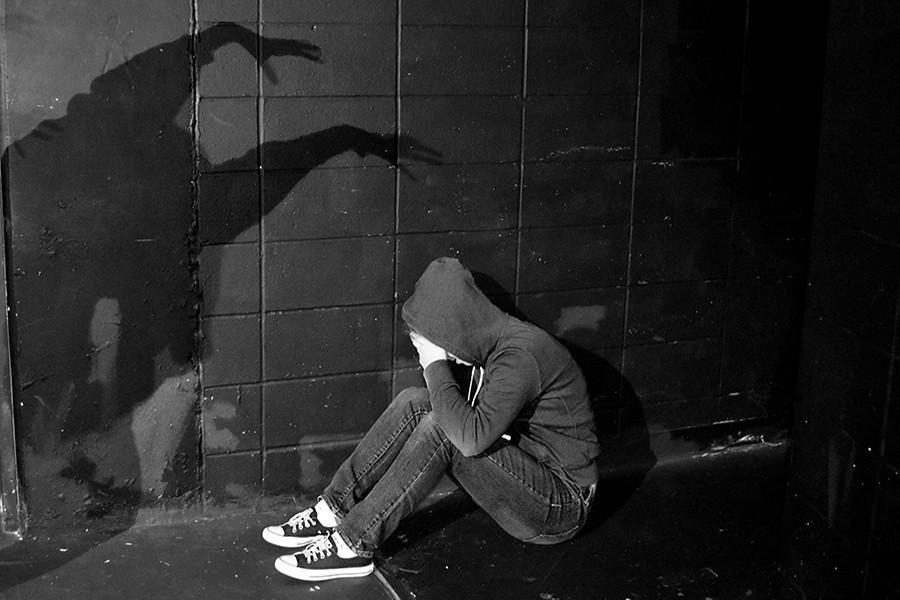Whether you think about it or not, behind the faces of your peers, many struggle against mental illnesses from anxiety, to depression, Attention Deficit Disorder (ADD), Attention Deficit Hyperactivity Disorder (ADHD) and hundreds of other types of disorders.
“I have ADD,” sophomore Megan Larsen said. “It is a disorder; it’s not some quirky thing that you have and it’s cute. It’s not. It’s a disorder, and I dislike having it.”
But not all problems people with mental disorders face are the symptoms of the disorders themselves. It is not uncommon to see negative stigma surrounding mental illnesses in public spaces.
“Teachers don’t really understand,” Larsen said. “It’s mostly with students though. If I would tell them, they would try to diagnose me. What really offends me though is when they try to diagnose themselves. They’ll say, I have ADD because I don’t like doing my homework. That doesn’t count.”
As there are often no visible symptoms to mental illnesses, it is often hard for those unaffected to try to compare the effects of mental and physical illnesses.
“They’re uneducated. They don’t get that it’s an actual mental hindrance and disorder. They don’t excuse you. You have to be physically hurt, like someone with a broken leg. If you have depression, ADD, anxiety, ADHD, they just dismiss it, seeing it not as a real thing but just as an excuse,” Larsen said.
But what exactly is causing all this stigma? Inaccurate usage of words such as “Obsessive Compulsive Disorder” (OCD), “panic attacks” and “bipolar” can be offensive to those who deal with these illnesses. The problem with this, to mental health advocates, is that people are using it as descriptors for people who do not have mental illness. In a Pathfinder survey, 50 percent of students have seen disorders used as adjectives.
“I have noticed a concerning amount of people using phrases such as I’m so OCD or She is so OCD very casually,” junior Parker Nenonen said. “OCD can be a very debilitating disease to those who have to live with it every single day. It would be fine to use it if it is not being destructive or hurtful to other people, such as those who actually have the disease.”
In fact, in the Pathfinder survey, 55 percent of students have seen people being bullied for a mental disorder they had.
“I think a lot of people treat mental illnesses as some sort of contagious disease. When someone finds out that someone has depression, anxiety or any other mental illness, they automatically think it makes them a different person and not someone that they can be friends with or be around. It caused them to distance themselves from those people. It’s not contagious and it’s not going to hurt you. It’s just something different about you,” freshman Rachel Neupert said.
Ignorance of mental health conditions can lead to disability, losing your job and less productivity according to a study by the Texas Hospital Association.
“People say, You’re fine, what’s wrong with you? It’s just one little thing. It could be just one little thing, but that little thing can hurt you. A lot of people have told me to get over it, and they don’t understand what you and I go through,” depression-diagnosed freshman Breann Ramage said. “Step into my shoes for a day. It’s tough. It’s really tough.”
Mental health also can affect school-life drastically, and according to a study by National Alliance on Mental Illness, 50 percent of students who receive in-school assistance for their mental illnesses drop out.
“Students should be mindful of others who are going through tough things. People are all people, and you don’t know what people are going through,” freshman Tim McAuliffe said. “You have to step into other people’s shoes before you say whatever you are about to say. I feel like that would solve a lot of problems if people think before saying, This person is crazy.”
Students who advocate for mental health awareness believe the school should take more action to support students who need help.
“There should be a place to get mental health resources. You don’t know the situation at home either. They might not be able to tell because of fear of safety. There should be a mental health resource office here that students can get information,” McAuliffe said.
The school has a clinical therapist, Katie Corbin, but she does not have her own office and works under Catholic Family Services rather than being Parkway-employed.
“I am at school everyday,” Corbin said. “I work primarily out of the counseling office, but I am mobile.”
Corbin works in different offices different days rather than having her own room, which she believes would be easier both for her and students. Despite that, she still can see students who need therapy if they set up an appointment in the counseling.
“We always tell people the counseling center as a whole is a safe place. Kids will sometimes come in and just sit down,” Corbin said. “For the most part, there’s ways to have them in a room just to come in. Sometimes you do just need to get away and things can get overwhelming and you don’t want your peers to see you but you still want to get certain emotions out.”
But even with therapy and support, there is no cure to mental illness.
“Sometimes you assume you know what’s going on in people’s lives, and you might see a girl walking down the hall that looks like she has it all together. You wouldn’t think there is a worry on her mind. But I will tell you that she probably does. And teens are really good at covering that up. You should never assume anything,” Corbin said. “Have empathy, and know that you don’t see the same world they do, and they might have some really heavy things that they are dealing with that nobody knows about.”




![Freshman Daphne Stokes looks at a table with Veterans Day flyers and information on Nov. 11. Stokes, along with other West High students, like senior Alexander Lewinski, passed by the table in the cafeteria with army recruitment information and giveaways for students to observe during lunch. “Talking with [the recruiters] has definitely helped me [find] where I wanted to go, more than anything else,” Lewinski said.](https://pwestpathfinder.com/wp-content/uploads/2025/11/DSC_1227-2-1200x800.jpg)
![Helping a customer, print room assistant Gretchen Williams operates her booth at the West High Craft Fair from Oct. 25-26. This was Williams’ first time participating in the Craft Fair with her new craft shop, Gs Beaded Boutique. “People have always said, over the years, ‘you should open something.’ [I replied that] I would rather just make [my crafts as] gifts for people. I just started [the online store] up, and it's been okay. I'm always surprised [by] how many views I get and [the] people from different states buying things; somebody from Alaska bought something the other day.”](https://pwestpathfinder.com/wp-content/uploads/2025/11/DSC0451-2-1200x799.jpg)
![Gesturing toward the club’s name on the board, Global Youth Aid co-president year Daniah Alsagheer discusses upcoming service projects with members during a meeting on Oct. 30. “We might be one club at one school, but together, we’re [part of] something much bigger,” Alsagheer said.](https://pwestpathfinder.com/wp-content/uploads/2025/11/DSC00949-1200x800.jpg)
![Focused on providing exceptional service, sophomore Darsh Mahapatra carefully cleans the door of a customer’s car. Mahapatra has always believed his customers deserve nothing less than the best. “[If] they’re trusting us with their car and our service, then I am convinced that they deserve our 100 percent effort and beyond,” Mahapatra said.](https://pwestpathfinder.com/wp-content/uploads/2025/10/DSC_0018-1200x800.jpg)
![Sophomore Aleix Pi de Cabanyes Navarro (left) finishes up a soccer game while junior Ava Muench (right) warms up for cross country practice. The two came to Parkway West High School as exchange students for the 2025-2026 school year. “The goal for the [exchange] program is to provide opportunities for both Parkway students and our international exchange students to learn about other cultures, build connections and become confident, capable, curious and caring — Parkway’s Four C’s — in the process,” Exchange Program Lead Lauren Farrelly said.](https://pwestpathfinder.com/wp-content/uploads/2025/10/Feature-Photo-1200x800.png)

![Gazing across the stage, sophomore Alexis Monteleone performs in the school theater. The Monteleone family’s band “Monte and the Machine” has been releasing music since 2012, but Alexis started her own solo career in 2024 with the release of her first single, Crying Skies. “My whole family is very musical, [and I especially] love writing [songs with them],” Monteleone said.](https://pwestpathfinder.com/wp-content/uploads/2025/09/DSC7463-1200x798.jpg)
![Amid teaching a lesson to her AP Calculus BC class, Kristin Judd jokes alongside her students in their funny remarks. Judd has always enjoyed keeping the mood light in her classroom, along with on the volleyball court. “[I enjoy] that side talk where you see [or] overhear a conversation and chime in, or somebody says something funny,” Judd said.](https://pwestpathfinder.com/wp-content/uploads/2025/09/image-1200x730.jpg)
![Eyeing the ball, junior Ella McNeal poses for her commitment pictures at Clemson University. McNeal’s commitment comes after months of contact with top Division 1 soccer programs. “ It has taken a lot to get to where I am, but I know that [what] I've already been through is just the beginning, and I can't wait for what is to come,” McNeal said.](https://pwestpathfinder.com/wp-content/uploads/2025/09/IMG_4926-1200x900.jpeg)

![Sophomore Shree Sikkal Kumar serves the ball across the court in a match against Lindbergh. Sikkal Kumar has been a varsity member of the varsity girls’ tennis team for two years, helping her earn the number two rank in Class 2 District 2.“When matches are close, it’s easy to get nervous, but I [ground] myself by[staying] confident and ready to play,” Sikkal Kumar said.](https://pwestpathfinder.com/wp-content/uploads/2025/11/DSC2801-1200x798.jpg)
![Dressed up as the varsity girls’ tennis coach Katelyn Arenos, senior Kate Johnson and junior Mireya David hand out candy at West High’s annual trunk or treat event. This year, the trunk or treat was moved inside as a result of adverse weather. “As a senior, I care less about Halloween now. Teachers will bring their kids and families [to West’s Trunk or Treat], but there were fewer [this year] because they just thought it was canceled [due to the] rain. [With] Halloween, I think you care less the older you get,” Johnson said.](https://pwestpathfinder.com/wp-content/uploads/2025/10/DSC00892-1-1200x800.jpg)
![Leaning on the podium, superintendent Melissa Schneider speaks to Parkway journalism students during a press conference. Schneider joined Parkway in July after working in the Thompson School District in Colorado. “My plan [to bond with students] is to get things on my calendar as much as possible. For example, being in [classes] is very special to me. I am trying to be opportunistic [meeting] kids [and] being in [the school] buildings. I have all the sports schedules and the fine arts schedules on my calendar, so that when I'm available, I can get to them,” Schneider said.](https://pwestpathfinder.com/wp-content/uploads/2025/09/IMG_5425-1200x943.jpeg)

![Leaping through the air, senior Tyler Watts celebrates his first goal of the season, which put the Longhorns up 1-0 against the Lafayette Lancers. Watts decided to play soccer for West for his last year of high school and secured a spot on the varsity roster. “[Playing soccer for West] is something I had always dreamed of, but hadn’t really had a good opportunity to do until now. It’s [really] fun being out [on the field], and I’m glad I decided to join the team. It’s just all about having fun with the boys and enjoying what time we have left together,” Watts said.](https://pwestpathfinder.com/wp-content/uploads/2025/09/DSC_1951-1200x855.jpg)

![Shifting global trade, President Donald Trump’s tariffs are raising concerns about economic stability for the U.S. and other countries alike. “[The tariffs are] going to pose a distinct challenge to the U.S. economy and a challenge to the global economy on the whole because it's going to greatly upset who trades with who and where resources and products are going to come from,” social studies teacher Melvin Trotier said.](https://pwestpathfinder.com/wp-content/uploads/2025/05/MDB_3456-1200x800.jpg)

![Pitching the ball on Apr. 14, senior Henry Wild and his team play against Belleville East. Wild was named scholar athlete of the year by St. Louis Post-Dispatch after maintaining a high cumulative GPA and staying involved with athletics for all of high school. “It’s an amazing honor. I feel very blessed to have the opportunity to represent my school [and] what [it] stands for,” Wild said.](https://pwestpathfinder.com/wp-content/uploads/2025/05/unnamed-6-1200x714.jpg)

maddie cooke • Dec 7, 2015 at 11:10 am
i enjoyed it, thank you sydney it was good.